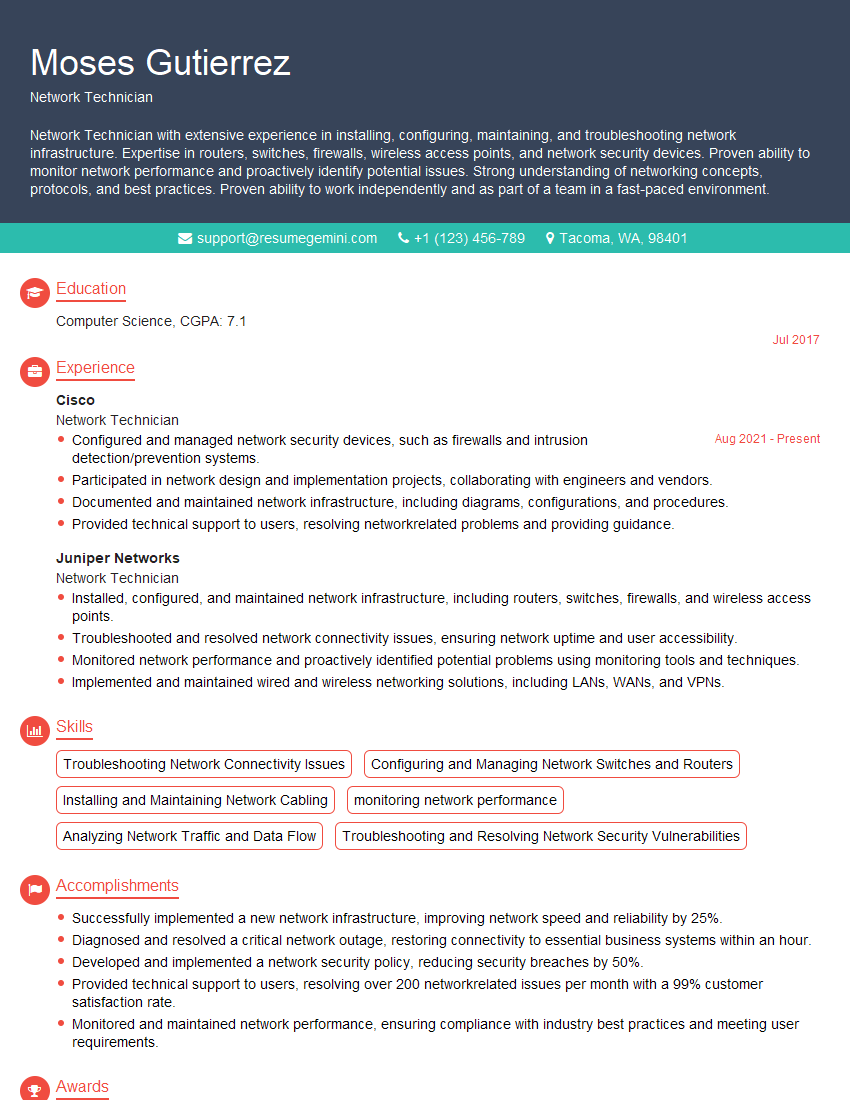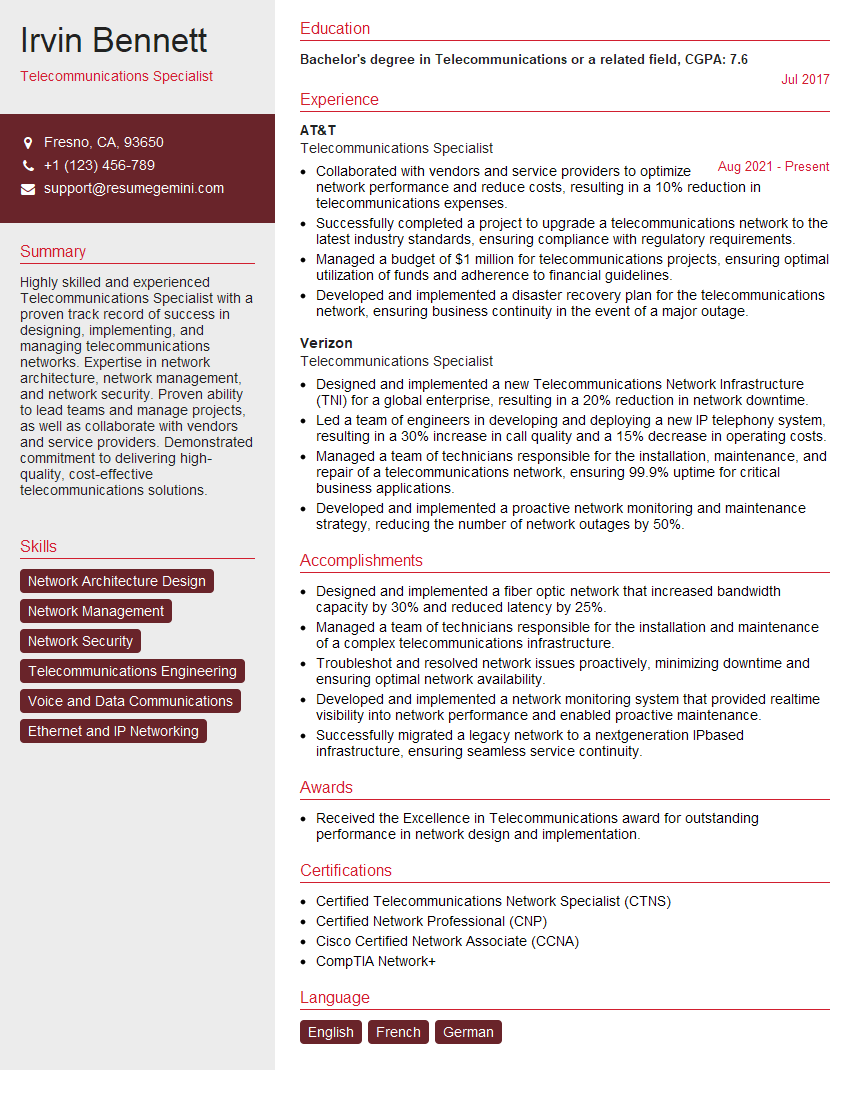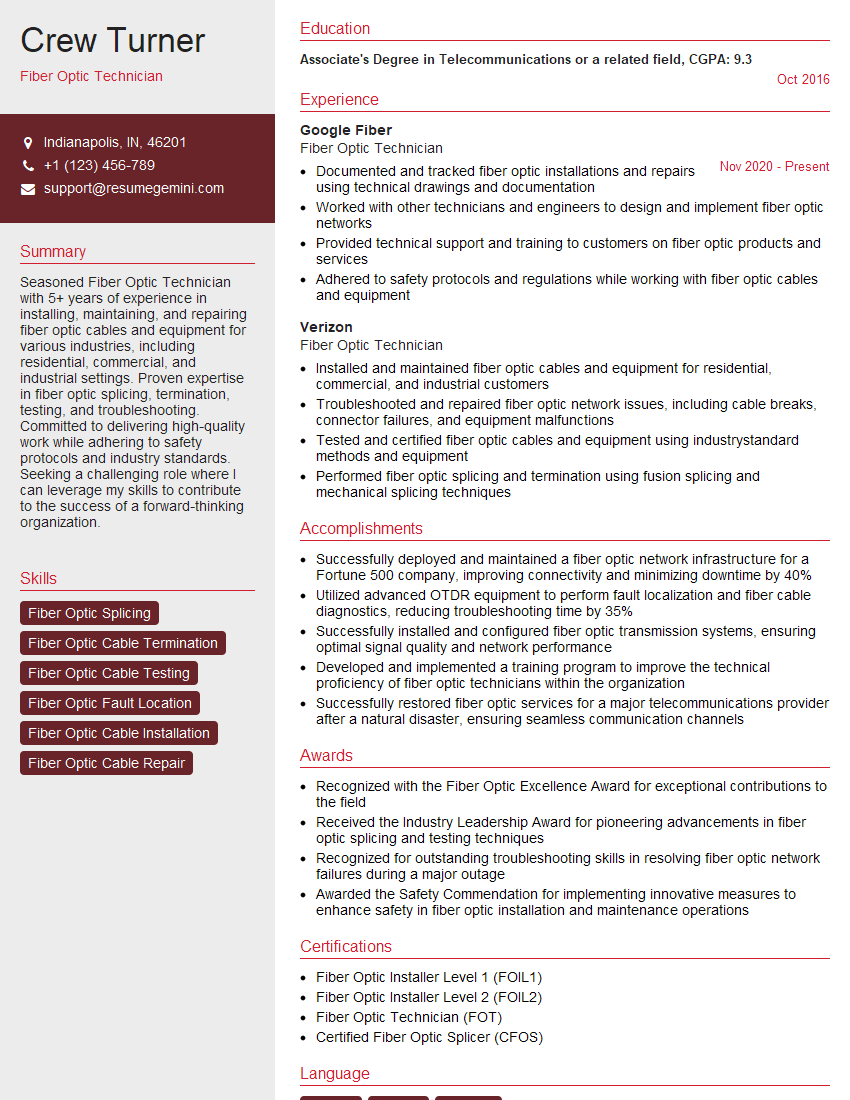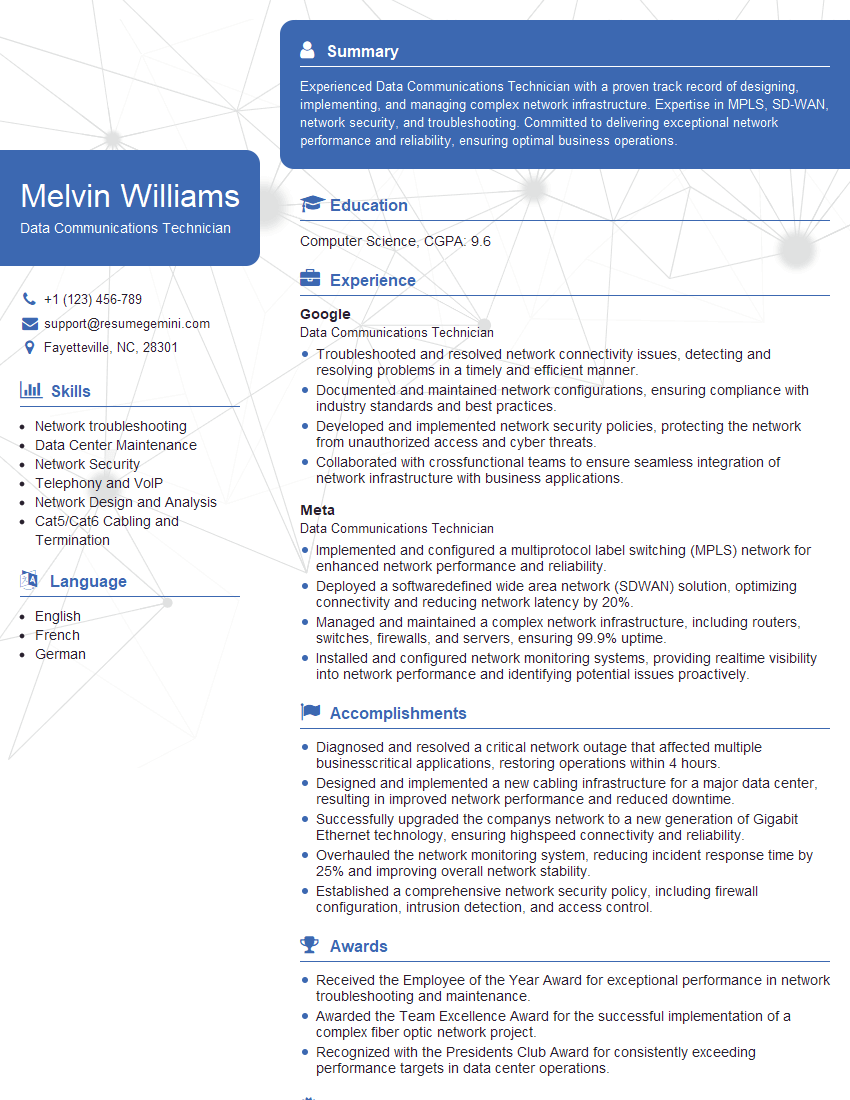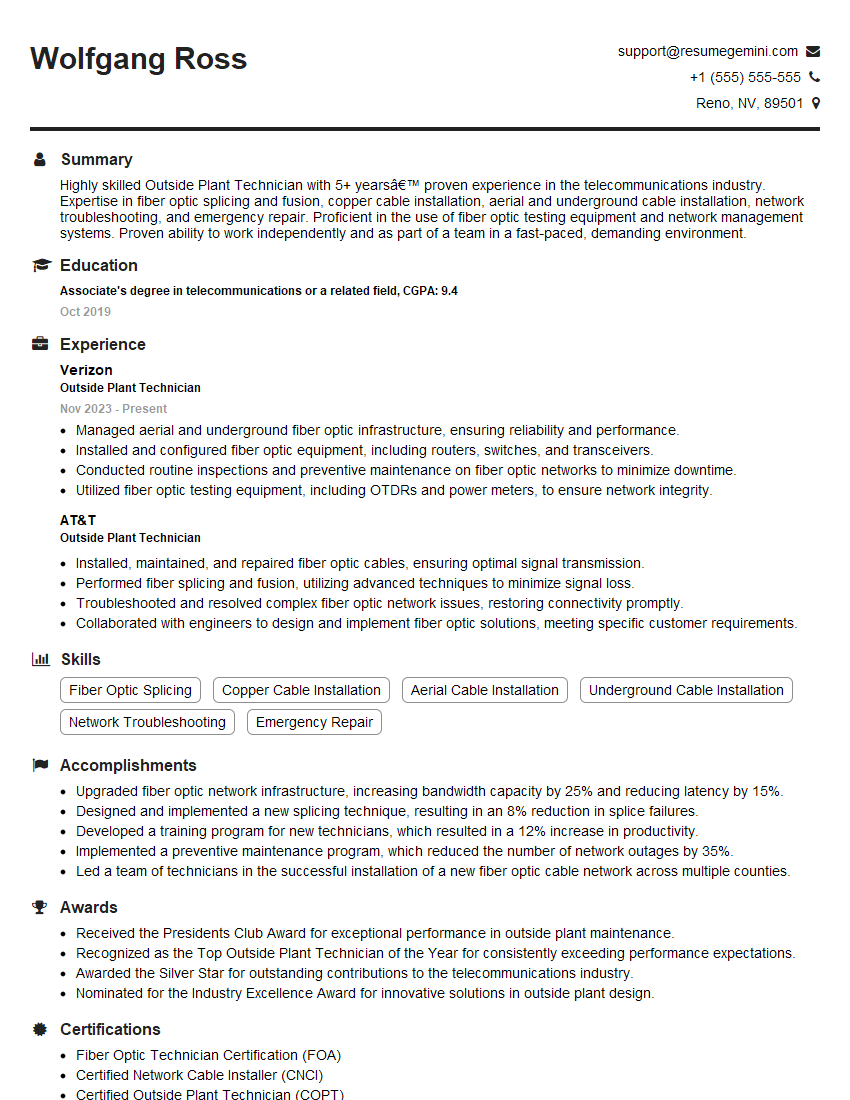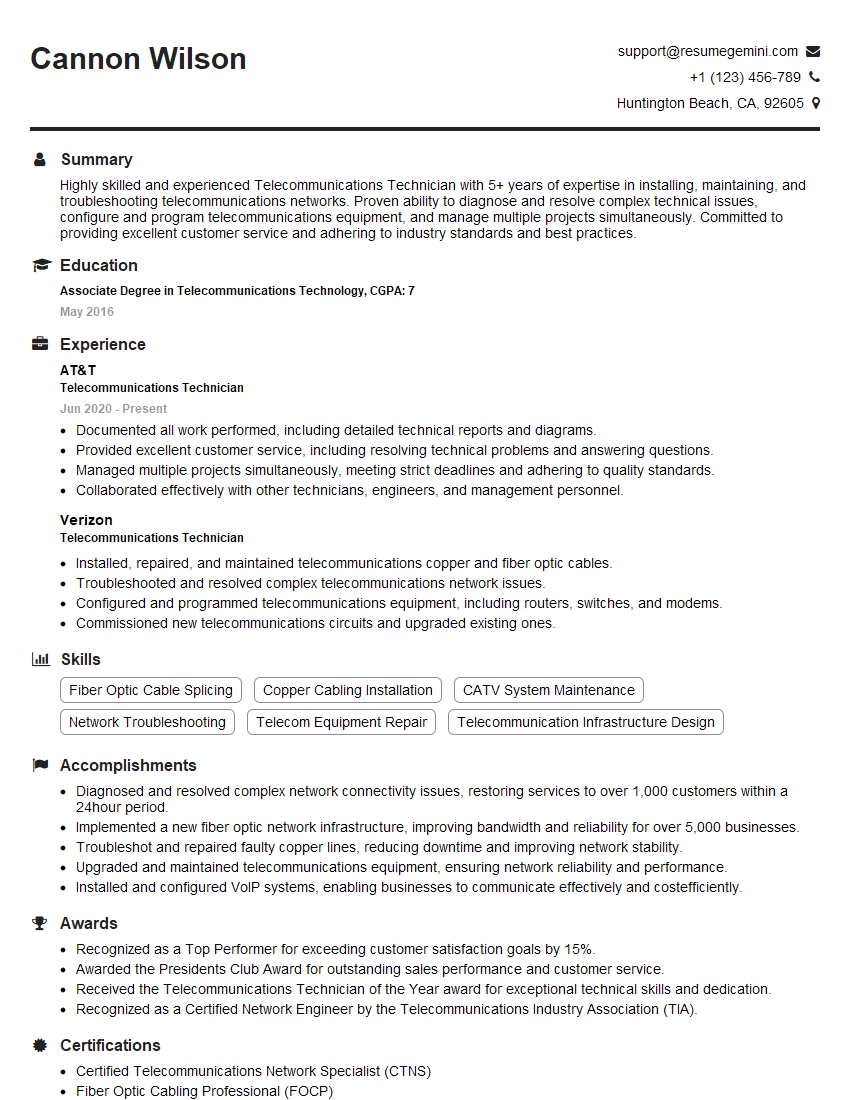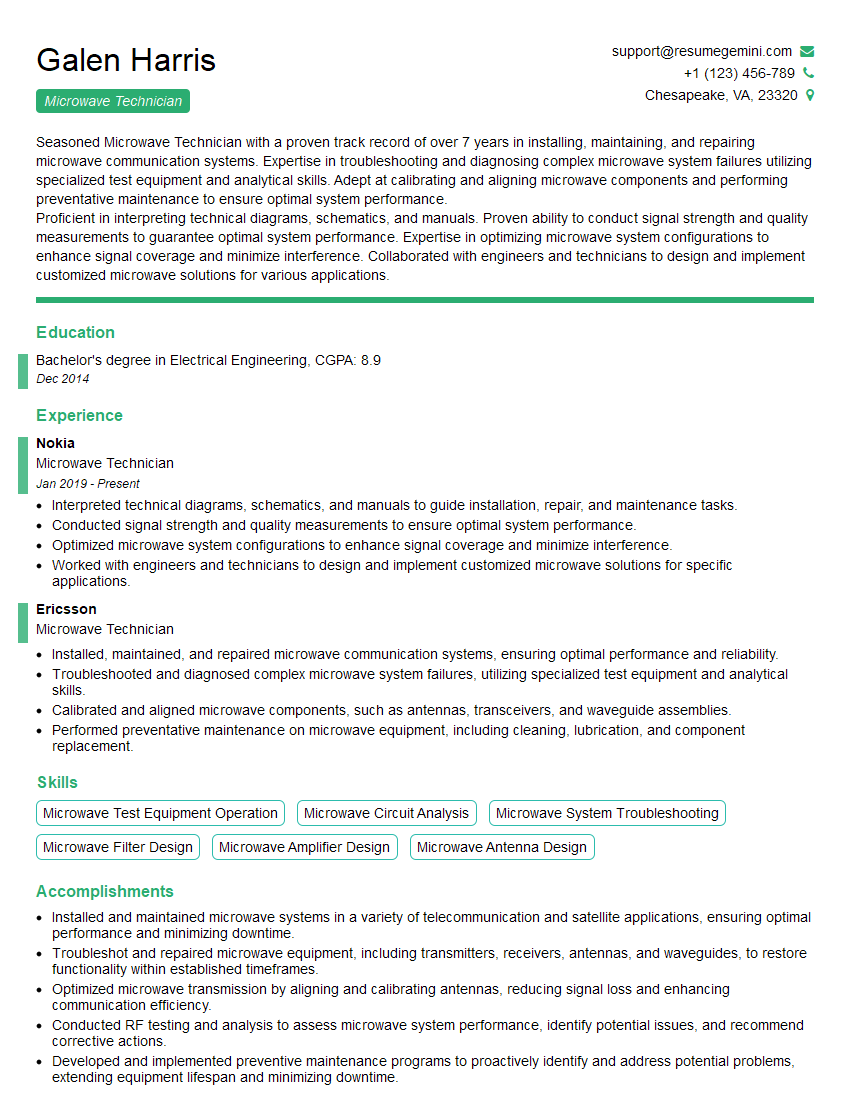Every successful interview starts with knowing what to expect. In this blog, we’ll take you through the top Telecommunications Equipment Installation and Maintenance interview questions, breaking them down with expert tips to help you deliver impactful answers. Step into your next interview fully prepared and ready to succeed.
Questions Asked in Telecommunications Equipment Installation and Maintenance Interview
Q 1. Describe your experience with fiber optic cable splicing.
Fiber optic splicing is a crucial skill in telecommunications, involving the precise joining of two fiber optic cables to maintain signal transmission. It requires meticulous attention to detail and specialized equipment. My experience encompasses various splicing techniques, including fusion splicing and mechanical splicing.
Fusion splicing uses a fusion splicer to melt and fuse the fiber ends together, creating a permanent, low-loss connection. This method is preferred for its superior performance and longevity. I’ve successfully fused thousands of fibers, consistently achieving splice losses well below industry standards. I’m proficient in using various fusion splicer models and troubleshooting issues such as poor cleave quality or misalignment leading to high loss.
Mechanical splicing, on the other hand, uses a mechanical connector to join the fibers. While faster than fusion splicing, it generally results in higher splice loss and is less durable. I utilize this method when speed is critical or in situations where fusion splicing is impractical, for example, in tight spaces or during emergency repairs. My experience includes working with various mechanical connectors, ensuring proper alignment and minimizing signal degradation.
Throughout my career, I’ve maintained detailed records of every splice, including splice loss measurements and splice location, ensuring easy traceability and facilitating efficient network maintenance.
Q 2. Explain the process of troubleshooting a faulty DSL line.
Troubleshooting a faulty DSL line involves a systematic approach, starting with the most straightforward checks and progressing to more complex investigations. It’s like diagnosing a medical condition – you need to gather clues systematically.
First, I’d check the obvious: Is the modem properly connected? Are all the cables securely plugged in at both ends? A simple cable wiggle can sometimes resolve the issue. Then, I’d check the DSL light on the modem. A solid light usually indicates a connection; a blinking or absent light suggests a problem.
Next, I’d check the line itself. Using a DSL line tester, I’d measure the signal strength and noise levels. Low signal strength indicates a problem with the line’s physical integrity or the distance from the central office. High noise levels may indicate interference from other sources.
If the problem persists, I’d investigate the wiring in the customer’s premises. Checking for loose connections, damaged cables, and interference from other devices is crucial. Sometimes even a faulty filter on another phone line in the house can affect the DSL signal.
If the issue lies beyond the customer’s premises, I’d contact the telecommunications provider’s technical support for assistance. They have specialized tools and access to the central office equipment to further diagnose the problem and potentially identify issues within their infrastructure – perhaps a faulty DSLAM (Digital Subscriber Line Access Multiplexer) or a problem on the main line itself.
Q 3. What are the safety precautions you take when working with high-voltage equipment?
Safety is paramount when working with high-voltage equipment. My approach is based on a strict adherence to established safety protocols and a comprehensive understanding of potential hazards. It’s not just about following rules; it’s about a mindset of proactive risk mitigation.
- Lockout/Tagout Procedures: Before working on any high-voltage equipment, I always employ lockout/tagout procedures to ensure the power is completely isolated and cannot be accidentally re-energized. This involves physically locking and tagging the circuit breaker or disconnect switch, ensuring nobody can accidentally turn the power back on.
- Personal Protective Equipment (PPE): I always wear appropriate PPE, including insulated gloves, safety glasses, and arc flash protective clothing rated for the voltage level. This equipment provides a crucial barrier against electrical shock and burns.
- Grounding and Bonding: I ensure that the equipment is properly grounded and bonded to prevent the build-up of static electricity. This is particularly important when working near energized equipment or in damp conditions.
- Awareness of Surroundings: Before commencing work, I always thoroughly assess the work area for any hazards, including obstacles, sharp objects, and potential trip hazards. The work area should be well lit, and other workers must be aware of what I’m doing.
- Regular Training and Certification: I maintain up-to-date certifications and training in safety procedures for handling high-voltage equipment. Continuous learning is critical to keeping my skills sharp and ensuring my understanding of the latest safety regulations remains current.
A near miss or a past accident is always a great learning opportunity, leading to a stronger commitment to safe working practices.
Q 4. How do you test the continuity of a cable?
Testing cable continuity verifies that there is an unbroken electrical path from one end of a cable to the other. This is crucial for ensuring the cable is functional and hasn’t experienced any breaks or shorts.
The most common method uses a multimeter set to the continuity test mode (usually represented by a diode symbol). One multimeter lead is connected to one end of the cable, and the other lead is connected to the other end. A continuous beep indicates a good connection, while the absence of a beep suggests a break somewhere along the cable.
Example: If testing a twisted pair cable, I would test continuity between each individual wire in the pair. A break in one wire means the entire pair is faulty for that circuit.
For longer cables or cables with multiple conductors, a Tone Generator and Probe can be used. The tone generator sends a signal through the cable, and the probe can locate the signal at the other end. This is particularly helpful in tracing cables within a bundle or locating a break within a long run of cable. This is especially helpful when cables run along walls or under the ground.
In some cases, Time Domain Reflectometry (TDR) is used to pinpoint the exact location of a break or fault in the cable. TDR measures the time it takes for a signal to travel down the cable and reflect back, allowing for precise location of faults even in underground or otherwise difficult to access locations. This is a very sophisticated method.
Q 5. What are the different types of coaxial cables and their applications?
Coaxial cables are used for transmitting high-frequency signals with minimal signal loss. They consist of a central conductor surrounded by a dielectric insulator, a conductive shield, and an outer jacket. Different types cater to various applications based on their impedance, shielding, and connector types.
- RG-59: Commonly used for cable television (CATV) distribution networks and some security systems. It’s relatively inexpensive and easy to work with, but it has a higher signal loss compared to other types.
- RG-6: A thicker and more robust cable than RG-59, providing better signal quality and less attenuation over longer distances. It’s widely used for CATV and high-definition television (HDTV) installations. It’s the standard in most residential installations.
- RG-11: A thicker cable offering even better performance than RG-6, used mainly for long-distance cable television applications or in situations where very high bandwidths are required. Used less frequently due to its bulk.
- LMR-Series: Low-loss cables designed for high-frequency applications such as radio and microwave transmissions. They offer significantly lower attenuation compared to RG-59 and RG-6, crucial for maintaining signal quality over long distances at very high frequencies.
The choice of coaxial cable depends on the application’s specific needs, considering factors such as frequency, distance, and required signal quality. For example, a low-loss cable like LMR is essential for long-distance microwave links, while RG-6 is sufficient for most home cable installations.
Q 6. Explain your experience with installing and configuring network switches.
My experience with installing and configuring network switches spans various models and network environments. It’s not just about plugging things in; it’s about understanding the network’s needs and optimizing performance.
Installation involves careful planning and execution. This starts with assessing the network topology and bandwidth requirements. Then, I’ll physically install the switch in a secure, well-ventilated location, ensuring proper cable management. I also ensure the switch has the correct power supply and is connected to the network.
Configuration involves using the switch’s command-line interface (CLI) or a web-based interface. I’m proficient in configuring various parameters, including VLANs (Virtual Local Area Networks) for network segmentation, port security to enhance network security, and QoS (Quality of Service) to prioritize certain types of traffic (e.g., VoIP over general web traffic).
I’ve worked with a wide range of switch models, from small unmanaged switches to sophisticated managed switches offering advanced features such as PoE (Power over Ethernet), Layer 3 routing capabilities, and link aggregation (LAG).
A recent project involved installing and configuring a high-capacity managed switch in a large office building. We implemented VLANs to segregate network traffic for various departments, improving network security and performance. We also used PoE to power IP phones and wireless access points, reducing cabling complexity. This type of project emphasizes thorough planning and attention to detail.
Q 7. How familiar are you with different types of network topologies (e.g., star, ring, mesh)?
Network topologies dictate how devices are connected and communicate within a network. Understanding these topologies is essential for designing efficient and reliable networks.
- Star Topology: A central hub (typically a switch or router) connects all devices. It’s the most common topology due to its simplicity, scalability, and ease of troubleshooting. If one device fails, the rest remain unaffected. Think of it like a starburst.
- Ring Topology: Devices are connected in a closed loop, with data flowing in one direction. It’s less common now, but it was once popular in local area networks (LANs). A failure in any single point can disrupt the entire network.
- Mesh Topology: Devices are connected through multiple redundant paths. This is highly resilient to failures since multiple paths exist. It’s often used in critical network infrastructures, such as those requiring high availability.
- Bus Topology: All devices are connected to a single cable or bus. It’s simple, but a failure anywhere on the bus affects the whole network. Relatively uncommon now except in very simple, small networks.
- Tree Topology: A hybrid topology combining elements of star and bus topologies. It is hierarchical and scalable. It’s a common way of implementing large networks.
My experience involves designing and troubleshooting networks utilizing these topologies. The best choice depends on factors like network size, required redundancy, and budget considerations. For example, a mesh topology might be ideal for a critical infrastructure network, while a star topology is usually sufficient for a small office network.
Q 8. Describe your experience with IP addressing and subnetting.
IP addressing and subnetting are fundamental to network design and management. IP addressing assigns a unique numerical label to each device on a network, allowing them to communicate. Subnetting divides a larger network into smaller, more manageable subnetworks. Think of it like dividing a large city into smaller neighborhoods for easier navigation and resource allocation.
My experience encompasses designing, implementing, and troubleshooting networks using various IP addressing schemes (IPv4 and IPv6). I’m proficient in calculating subnet masks, determining the number of usable IP addresses within a subnet, and allocating IP addresses efficiently to minimize IP address wastage. For instance, I recently designed a subnet for a new office building, using a /24 network (255.255.255.0 subnet mask) to accommodate 254 devices, carefully considering future expansion needs. I also have experience with VLSM (Variable Length Subnet Masking) for optimized IP address allocation in larger, complex networks. This allows for efficient use of IP addresses by assigning smaller subnets to smaller sections of the network, rather than one large subnet for the entire network.
I regularly utilize tools like subnet calculators to aid in these calculations, ensuring accuracy and preventing conflicts. Understanding subnetting is crucial for efficient network planning, security, and troubleshooting; incorrectly configured subnets can lead to communication failures and security vulnerabilities.
Q 9. How do you diagnose and resolve internet connectivity issues?
Diagnosing internet connectivity issues involves a systematic approach, starting with the simplest checks and progressing to more complex investigations. Think of it as a detective investigating a crime scene – you need to collect evidence systematically to find the culprit.
My troubleshooting process typically begins by checking the physical connections: cables, ports, and power supplies. Then, I move to verifying basic network configurations: IP address, subnet mask, default gateway, and DNS settings. Tools like ping and tracert (or traceroute) are invaluable in this phase. A successful ping to the default gateway indicates a problem beyond the local network. tracert shows the path to a destination and helps identify the point of failure. I also examine network devices like routers and switches for errors or overload.
If the problem persists, I investigate higher-level issues such as DNS resolution problems (using nslookup), firewall restrictions, and potential ISP-related outages. I utilize network monitoring tools to identify bottlenecks and performance issues. Communication with the ISP is essential if the problem lies outside the local network. I’ve successfully resolved numerous connectivity issues, ranging from simple cable faults to complex routing problems, consistently applying this systematic approach.
Q 10. What is your experience with testing and configuring VoIP systems?
VoIP (Voice over Internet Protocol) systems offer cost-effective voice communication over data networks. My experience encompasses the full lifecycle: installation, configuration, testing, and troubleshooting. I’m familiar with various VoIP technologies, including SIP (Session Initiation Protocol) and H.323.
Testing involves verifying call quality (latency, jitter, packet loss), codec compatibility, and call routing. I utilize specialized VoIP testing tools to measure these parameters and identify potential issues. Configuration typically involves setting up VoIP gateways, configuring SIP trunks, and setting up user accounts. Troubleshooting often involves analyzing call logs, checking network performance, and verifying firewall settings to ensure smooth voice communication. For example, I recently resolved a VoIP issue where poor call quality was caused by insufficient bandwidth. This required optimizing the network configuration to prioritize VoIP traffic.
Experience with various VoIP platforms (e.g., Asterisk, Cisco CallManager) and an understanding of QoS (Quality of Service) are essential for ensuring optimal performance and reliability of VoIP systems.
Q 11. Explain your experience with wireless network installation and troubleshooting.
Wireless network installation and troubleshooting require a deep understanding of radio frequency propagation, network security, and various wireless technologies (802.11a/b/g/n/ac/ax). Think of it like setting up a radio broadcast – signal strength, interference, and placement are key.
My experience includes site surveys to assess the area and plan optimal placement of access points to ensure good coverage and minimize interference. This involves using professional-grade wireless survey tools to analyze signal strength, channel utilization, and potential interference sources. I’m adept at configuring various wireless security protocols (WPA2/WPA3) to protect the network from unauthorized access. Troubleshooting wireless issues often involves identifying interference from other devices, optimizing channel selection, and adjusting access point power levels.
I’ve successfully installed and maintained wireless networks in various environments, from small offices to large campuses, always ensuring high performance and security.
Q 12. Describe your experience with microwave communication systems.
Microwave communication systems utilize radio waves in the microwave frequency range for long-distance communication. These systems provide high-bandwidth point-to-point links and are crucial in situations where fiber optic cables are not feasible or cost-effective. Imagine it as a highly focused beam of light carrying information across vast distances.
My experience involves the installation, alignment, and maintenance of microwave links. This includes aligning antennas precisely to ensure optimal signal strength and minimize signal loss. Troubleshooting involves analyzing signal quality, identifying interference, and addressing issues like fading and atmospheric attenuation. Specialized test equipment, such as spectrum analyzers and signal level meters, is critical for this work. I’ve worked on various microwave systems, from short-range links to long-haul microwave networks, and am familiar with the challenges related to environmental factors and signal interference.
Understanding propagation characteristics and interference sources is paramount in maintaining the reliability of these systems.
Q 13. What is your experience with working with various types of telecommunications test equipment?
Proficiency with telecommunications test equipment is crucial for accurate diagnosis and efficient troubleshooting. I’m experienced with a wide range of tools, each serving a specific purpose. Think of them as specialized medical instruments for diagnosing network problems.
This includes OTDRs (Optical Time-Domain Reflectometers) for fiber optic cable testing, multimeters for verifying voltage and continuity, spectrum analyzers for identifying interference sources, and protocol analyzers for capturing and analyzing network traffic. I also regularly utilize signal generators, power meters, and network analyzers depending on the specific task. My experience extends to using specialized test equipment for VoIP, microwave, and wireless systems, enabling me to perform comprehensive tests and quickly isolate faults. I understand the limitations and capabilities of each instrument and choose the appropriate tool for each situation.
Knowing how to interpret the data from these instruments is as important as using them – accurate diagnosis requires a deep understanding of the network and the technology involved.
Q 14. How do you manage and prioritize multiple tasks and deadlines?
Managing multiple tasks and deadlines effectively is a critical skill in this field. I utilize a combination of techniques to stay organized and meet deadlines consistently. I approach this using a combination of prioritization, planning, and efficient time management. Imagine it as running a well-oiled machine – every part needs to function smoothly and efficiently.
I typically begin by prioritizing tasks based on urgency and importance using methods like the Eisenhower Matrix (urgent/important). This allows me to focus on critical tasks first while delegating or scheduling less urgent ones. I utilize project management tools to track progress, set deadlines, and manage resources efficiently. Proactive communication with stakeholders is key to ensuring everyone is informed and expectations are managed. I’m also adept at adapting to changing priorities and unexpected issues, which often arise in a dynamic environment such as telecommunications installation and maintenance. My ability to stay calm under pressure, re-prioritize, and make timely decisions is crucial for consistent success.
Q 15. Describe a time you had to troubleshoot a complex technical problem. What was your approach?
One challenging troubleshooting experience involved a widespread service outage affecting a large number of VoIP (Voice over Internet Protocol) phone systems. Initially, the problem manifested as intermittent call drops and choppy audio. My approach was systematic and prioritized eliminating possibilities.
- Step 1: Isolate the Issue: I started by identifying the affected area – it wasn’t a single location, but rather multiple sites geographically dispersed. This ruled out a localized hardware failure.
- Step 2: Network Diagnostics: I then employed network monitoring tools (like SolarWinds or PRTG) to check for packet loss, latency, and jitter across the affected network segments. This revealed significantly high jitter levels consistent with QoS (Quality of Service) issues.
- Step 3: Identify the Root Cause: Further investigation into QoS settings on the routers and switches revealed an unexpected configuration change that inadvertently prioritized non-critical traffic over VoIP data. It was a simple error, but with far-reaching consequences.
- Step 4: Implement Solution & Verification: The solution involved restoring the default QoS settings, prioritizing voice traffic. I then implemented rigorous testing, making numerous test calls to verify that the issue was resolved. Post-resolution monitoring ensured stability.
This experience highlighted the importance of a structured approach to troubleshooting, starting with broad isolation and progressively focusing on more specific causes. Effective use of network monitoring tools was also key to pinpointing the source of the problem.
Career Expert Tips:
- Ace those interviews! Prepare effectively by reviewing the Top 50 Most Common Interview Questions on ResumeGemini.
- Navigate your job search with confidence! Explore a wide range of Career Tips on ResumeGemini. Learn about common challenges and recommendations to overcome them.
- Craft the perfect resume! Master the Art of Resume Writing with ResumeGemini’s guide. Showcase your unique qualifications and achievements effectively.
- Don’t miss out on holiday savings! Build your dream resume with ResumeGemini’s ATS optimized templates.
Q 16. What are your knowledge of various types of telecommunication protocols (e.g., TCP/IP, UDP)?
I have extensive experience with various telecommunication protocols. Understanding these protocols is fundamental to troubleshooting and installing telecommunications equipment.
- TCP/IP (Transmission Control Protocol/Internet Protocol): The foundation of the internet, TCP/IP provides reliable, connection-oriented communication. TCP ensures data delivery and order, while IP handles addressing and routing. Think of it like sending a registered letter – you know it will arrive and in the right order. Common uses include web browsing and file transfers (FTP).
- UDP (User Datagram Protocol): UDP is a connectionless protocol that prioritizes speed over reliability. It doesn’t guarantee delivery or order. Think of it as sending a postcard – it’s fast, but there’s no guarantee it will reach its destination. UDP is often used in streaming applications like video conferencing or online gaming where a slight delay is acceptable but speed is crucial.
- SIP (Session Initiation Protocol): Essential for VoIP systems, SIP manages the establishment, termination, and maintenance of voice and multimedia sessions over IP networks. It controls call setup, handling, and features like call transfer and hold.
- BGP (Border Gateway Protocol): The routing protocol that connects different autonomous systems (networks) on the internet, exchanging routing information to ensure efficient data transmission between networks.
My understanding of these protocols extends to their practical application in network design, configuration, and troubleshooting. I can analyze network traffic, identify protocol-specific issues, and implement appropriate solutions.
Q 17. What is your experience with preventative maintenance on telecommunications equipment?
Preventative maintenance is critical for ensuring the longevity and reliable operation of telecommunications equipment. My experience encompasses a wide range of tasks, including:
- Regular Inspections: Visual checks of equipment for signs of wear, damage, or overheating. This includes checking cabling, connectors, and power supplies.
- Firmware Updates: Keeping the firmware of switches, routers, and other devices up-to-date is crucial for security patches and performance improvements. This often requires careful planning to minimize downtime.
- Cleaning: Dust accumulation can affect cooling and performance. Regular cleaning, especially in server rooms, is crucial.
- Environmental Monitoring: Monitoring temperature, humidity, and power levels within equipment racks to ensure optimal operating conditions. Deviations can indicate potential problems.
- Performance Testing: Regularly testing network connectivity, speed, and latency to identify and address potential degradation before it leads to outages.
I follow manufacturer’s recommendations and best practices for preventative maintenance, creating schedules and documenting all tasks completed. This proactive approach minimizes costly repairs and ensures consistent service availability.
Q 18. Describe your experience with documenting your work and maintaining records.
Detailed documentation is a cornerstone of my work. I maintain comprehensive records using a combination of digital and physical methods.
- Digital Documentation: I utilize software like Microsoft Word and Excel to create reports, track maintenance activities, and maintain equipment inventories. Detailed descriptions of troubleshooting steps, including error codes, solutions, and test results, are meticulously recorded.
- Physical Documentation: For on-site installations or repairs, I maintain physical logs and diagrams of cabling, equipment placements, and network configurations. This ensures that information is readily accessible even without digital access.
- Ticketing Systems: I’m proficient with various ticketing systems (e.g., Jira, ServiceNow) to track requests, monitor progress, and document resolutions. This promotes efficient communication and accountability.
My documentation practices ensure that all work is traceable, allowing for easy analysis and future reference. Clear documentation is vital for ensuring smooth handoffs between team members and facilitating efficient troubleshooting down the line.
Q 19. How familiar are you with industry regulations and safety standards?
I’m thoroughly familiar with industry regulations and safety standards. My knowledge includes:
- OSHA (Occupational Safety and Health Administration): I adhere to all OSHA guidelines related to working at heights, handling electrical equipment, and working in confined spaces.
- NEC (National Electrical Code): I am aware of the NEC requirements for telecommunications cabling and equipment installations.
- TIA/EIA standards: I follow TIA/EIA standards for cabling infrastructure, ensuring compliance with industry best practices for data center and network cabling.
- Environmental regulations: I’m mindful of regulations concerning the disposal of electronic waste (e-waste) and the handling of hazardous materials.
Safety is paramount in my work. I prioritize risk assessment before undertaking any task and always follow appropriate safety procedures. Compliance with regulations is not just a requirement; it’s an essential part of ensuring a safe and efficient work environment.
Q 20. What is your experience with working in a team environment?
Teamwork is integral to successful telecommunications projects. I thrive in collaborative environments and value diverse perspectives. My experience in team settings includes:
- Collaboration & Communication: I’m adept at communicating technical information clearly to both technical and non-technical team members. Effective communication is crucial in resolving complex issues collaboratively.
- Problem-Solving: I actively participate in brainstorming sessions, offering solutions and contributing to the overall team effort. I’m comfortable seeking help when needed and providing assistance to others.
- Mentorship & Training: I am eager to share my knowledge and expertise, mentoring junior team members and helping to develop their skills.
- Project Management: I’ve been involved in projects requiring teamwork, contributing to project planning, task management, and meeting deadlines.
My collaborative approach ensures efficient project completion, promoting a positive and productive work environment.
Q 21. Describe your experience with cable management and organization.
Effective cable management is essential for a reliable and maintainable telecommunications infrastructure. My experience encompasses various techniques to ensure neatness, efficiency, and safety.
- Proper Labeling: I consistently label all cables with clear identifiers (e.g., source, destination, and function). This is crucial for troubleshooting and future maintenance.
- Cable Bundling & Strapping: I utilize cable ties, Velcro straps, and other methods to organize and bundle cables neatly. This improves airflow, reduces tripping hazards, and simplifies future modifications.
- Rack Organization: I’m skilled in utilizing rack-mounting equipment, properly securing devices, and maintaining efficient cable routing within server racks.
- Pathway Management: I ensure that cabling pathways are properly designated and utilized to avoid congestion and potential damage to cables.
My approach to cable management is not just about aesthetics. It’s a fundamental element of ensuring system reliability, efficient troubleshooting, and a safe working environment.
Q 22. Explain your knowledge of different types of network hardware (e.g., routers, modems, switches)?
Network hardware forms the backbone of any telecommunications system. My experience encompasses a wide range of devices, each with a specific function. Let’s look at three key components:
- Routers: These are the traffic cops of the network. They direct data packets between different networks, ensuring they reach their destination efficiently. Think of them as intelligent intersections, deciding the best route for your data. I’ve worked extensively with Cisco routers, configuring routing protocols like OSPF and BGP to optimize network performance and scalability. For instance, in one project, we used OSPF to create a highly available and redundant network for a large hospital, ensuring minimal disruption during maintenance.
- Modems: These devices translate data signals between your computer/device and your internet service provider (ISP). They act as the bridge between your local network and the wider world. I’m familiar with various modem types, including DSL, cable, and fiber modems, and understand the nuances of their configurations and troubleshooting. Troubleshooting a slow DSL connection, for example, might involve checking line noise, signal levels, and modem firmware updates.
- Switches: These devices connect multiple devices within a local area network (LAN). They intelligently forward data packets between devices based on their MAC addresses. Think of them as sophisticated connectors, ensuring that data only goes where it needs to go within your local network. I’ve configured both managed and unmanaged switches, understanding the advantages and disadvantages of each for different network setups. A managed switch allows for features like VLANs (Virtual LANs) which provide security and network segmentation—a critical aspect in securing a large office network.
Q 23. How familiar are you with different types of network cabling (e.g., CAT5e, CAT6, fiber)?
Network cabling is crucial for reliable data transmission. Different cable types offer varying speeds and distances. My experience covers a variety of options:
- CAT5e and CAT6: These twisted-pair copper cables are common in LANs. CAT6 offers higher bandwidth and less signal interference than CAT5e, making it suitable for faster networks like Gigabit Ethernet. I’ve installed and terminated both, carefully following standards to ensure optimal performance. A poorly terminated CAT6 cable, for example, can lead to signal loss or connectivity issues, requiring careful attention to detail.
- Fiber Optic Cable: This uses light pulses to transmit data over long distances at significantly higher speeds than copper cables. It’s immune to electromagnetic interference, making it ideal for backbone networks and high-bandwidth applications. I’ve worked with single-mode and multi-mode fiber, understanding the differences in their applications. One project involved installing fiber optic cabling for a high-speed internet connection to a remote location, requiring specialized fusion splicing techniques.
Beyond the cable type, I understand the importance of proper cable management, including labeling, strain relief, and avoiding bends or kinks to prevent signal degradation.
Q 24. How do you handle working at heights or in confined spaces?
Safety is my top priority. Working at heights and in confined spaces requires strict adherence to safety regulations and the use of appropriate personal protective equipment (PPE).
For work at heights, this includes using harnesses, safety lanyards, and fall arrest systems. I’m certified in fall protection and always inspect my equipment before commencing work. For confined spaces, I follow the proper entry procedures, including atmospheric testing, using appropriate respiratory protection, and having a standby person outside.
I’m always aware of potential hazards and take all necessary precautions to minimize risks. My experience includes working on both elevated cell towers and underground cable vaults, always prioritizing safety above all else.
Q 25. What are some common causes of network outages and how to troubleshoot them?
Network outages can stem from various sources. Troubleshooting requires a systematic approach. Common causes include:
- Hardware failures: Faulty routers, switches, modems, or cabling can all cause outages. My troubleshooting starts with visually inspecting the equipment for physical damage and checking power and cable connections.
- Software glitches: Bugs in router or switch firmware can disrupt network functions. This often involves checking logs, updating firmware, and performing a system reboot.
- Connectivity issues: Problems with ISP connectivity, misconfigured IP addressing, or DNS issues can prevent devices from accessing the network. I utilize network diagnostic tools like ping and traceroute to identify the point of failure.
- Security breaches: Unauthorized access or malicious attacks can disrupt services. Implementing robust security measures and monitoring network activity are crucial in preventing and addressing these issues.
My troubleshooting strategy involves isolating the problem, checking connections, testing components, and systematically eliminating potential causes. I utilize a combination of physical inspection, diagnostic tools, and network management systems to quickly identify and resolve the problem, always documenting the process and solution.
Q 26. How familiar are you with ticketing systems and reporting procedures?
I’m proficient in using various ticketing systems to manage and track work orders, including ServiceNow and Jira. This ensures efficient communication and accountability. I understand the importance of clear and concise reporting, providing accurate details about the problem, resolution steps, and time taken. This includes creating comprehensive reports summarizing work completed, issues encountered, and recommendations for preventative maintenance.
I’m meticulous in my documentation, creating detailed records of all activities, including timestamps, troubleshooting steps, and parts used. This helps with future troubleshooting and analysis.
Q 27. Describe your experience with using various types of hand tools and equipment.
My experience encompasses a broad range of hand tools and equipment relevant to telecommunications installation and maintenance. This includes:
- Hand tools: I’m proficient in using crimping tools for network cables, wire strippers, screwdrivers, and various other hand tools necessary for cable terminations, equipment installation, and troubleshooting. Proper tool use is crucial to ensure efficient and safe work practices.
- Testing equipment: I regularly use multimeters to test cable continuity and voltage, optical power meters for fiber optic testing, and network analyzers to diagnose network performance issues. Understanding the capabilities of each instrument is vital for efficient troubleshooting.
- Power tools: Where appropriate, I use power drills, cable saws, and other power tools to aid in installation, always adhering to safety regulations and using appropriate safety gear.
I’m comfortable using specialized tools as needed, including fusion splicers for fiber optics and specialized testing equipment for specific network technologies. Proper tool selection and maintenance are integral to performing quality work.
Key Topics to Learn for Telecommunications Equipment Installation and Maintenance Interview
- Network Topologies: Understanding different network architectures (star, mesh, ring, bus) and their practical implications in installation and troubleshooting.
- Fiber Optics: Knowledge of fiber optic cable types, splicing techniques, testing procedures (OTDR), and troubleshooting common fiber optic issues. Practical application includes understanding the benefits of fiber in high-bandwidth applications.
- Wireless Technologies: Familiarity with various wireless standards (Wi-Fi, cellular), antenna placement and optimization, and troubleshooting wireless connectivity problems. Practical application includes understanding site surveys and signal strength analysis.
- Troubleshooting Techniques: Mastering systematic troubleshooting methodologies, including utilizing diagnostic tools, interpreting error messages, and documenting solutions. This includes practical experience in isolating problems within complex systems.
- Safety Regulations and Procedures: Deep understanding of relevant safety standards and best practices for working with telecommunications equipment, including working at heights and handling potentially hazardous materials.
- Documentation and Reporting: Proficiency in documenting installation processes, maintaining accurate records, and generating clear and concise reports for clients or supervisors.
- Testing and Commissioning: Understanding the procedures and equipment used to test and commission telecommunications systems to ensure they meet performance specifications. This includes practical experience with various testing tools and procedures.
- Equipment Knowledge: Familiarity with a range of telecommunications equipment, including routers, switches, modems, and other related hardware. This involves understanding their functionalities and how they integrate within a larger system.
Next Steps
Mastering Telecommunications Equipment Installation and Maintenance opens doors to a rewarding and in-demand career with excellent growth potential. To maximize your job prospects, it’s crucial to present your skills effectively. Creating an ATS-friendly resume is essential for getting your application noticed by recruiters. We highly recommend using ResumeGemini to build a professional and impactful resume that highlights your expertise. ResumeGemini offers examples of resumes tailored to Telecommunications Equipment Installation and Maintenance to guide you through the process, ensuring your application stands out from the competition.
Explore more articles
Users Rating of Our Blogs
Share Your Experience
We value your feedback! Please rate our content and share your thoughts (optional).
What Readers Say About Our Blog
Hello,
We found issues with your domain’s email setup that may be sending your messages to spam or blocking them completely. InboxShield Mini shows you how to fix it in minutes — no tech skills required.
Scan your domain now for details: https://inboxshield-mini.com/
— Adam @ InboxShield Mini
Reply STOP to unsubscribe
Hi, are you owner of interviewgemini.com? What if I told you I could help you find extra time in your schedule, reconnect with leads you didn’t even realize you missed, and bring in more “I want to work with you” conversations, without increasing your ad spend or hiring a full-time employee?
All with a flexible, budget-friendly service that could easily pay for itself. Sounds good?
Would it be nice to jump on a quick 10-minute call so I can show you exactly how we make this work?
Best,
Hapei
Marketing Director
Hey, I know you’re the owner of interviewgemini.com. I’ll be quick.
Fundraising for your business is tough and time-consuming. We make it easier by guaranteeing two private investor meetings each month, for six months. No demos, no pitch events – just direct introductions to active investors matched to your startup.
If youR17;re raising, this could help you build real momentum. Want me to send more info?
Hi, I represent an SEO company that specialises in getting you AI citations and higher rankings on Google. I’d like to offer you a 100% free SEO audit for your website. Would you be interested?
Hi, I represent an SEO company that specialises in getting you AI citations and higher rankings on Google. I’d like to offer you a 100% free SEO audit for your website. Would you be interested?
good
